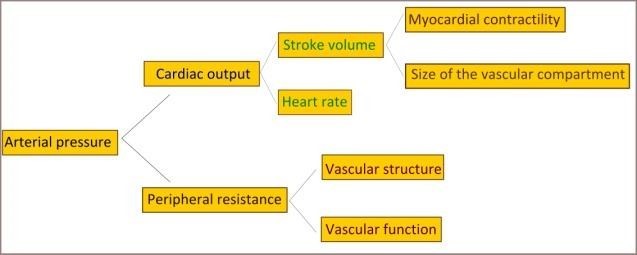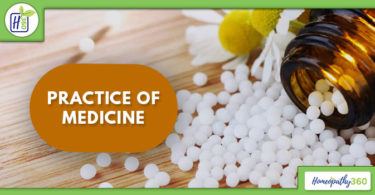Authored by:
Dr Manoj Kumar Sharma M.D (Hom.)
Assistant Professor, Department of Organon of Medicine
Govt. Pt. Jawahar Lal Nehru Homoeopathic Medical College, Kanpur
ABSTRACT
Hypertension, also known as high or raised blood pressure, is a condition in which the blood vessels have persistently raised pressure. Blood is carried from the heart to all parts of the body in the vessels.Each time the heart beats, it pumps blood into the vessels. Blood pressure is created by the force of blood pushing against the walls of blood vessels (arteries) as it is pumped by the heart. The higher the pressure the harder the heart has to pump. Hypertension” or”high blood pressure‟ is a condition in which the blood pressure in the arteries is chronically elevated. Homoeopathy –The Holistic Medicine can be proved very helpful in cases of hypertension.
INTRODUCTION
The normal level for blood pressure is 120/80, and a blood pressure of 140/90 or above is considered hypertension. High blood pressure is called “the silent killer” because it often causes no symptoms for many years, even decades, until it finally damages certain vital organs. Hypertension may be classified as essential or secondary. Essential hypertension is the term for high blood pressure with unknown cause .It accounts for about 95% of cases. Secondary hypertension is the term for high blood pressure with a known direct cause, such as kidney disease, tumors, or birth control pills.
CATEGORIZATION OF BLOOD PRESSURE IN ADULTS:-

CAUSES: Although the exact cause of hypertension is unknown but there are several factors that may increase the risk as well as they can result in hypertension.
Factors that can raise your risk of developing high blood pressure include:
- Age – the risk of developing high blood pressure increases as you get older
- A family history of high blood pressure
- A high amount of salt in your food.
- Lack of exercise
- Being overweight
- Regularly drinking large amounts of alcohol
- Smoking
- Long-term sleep deprivation
CAUSES OF HYPERTENSION-
- Diabetes
- Kidney Diseases.
- Long term kidney infections
- Obstructive sleep apnea.
- Narrowing the arteries supplying the kidney.
- Cushing’s syndrome, Acromegaly, Hyperaldosteronism, Pheochromocytoma.
- Lupus.
- Scleroderma.
- Medicines-contraceptive pills, steroids, NSAIDS, Herbal medicines containing liquorice, Cocaine, Amphetamine, Antidepressants etc.
SYMPTOMS:
Hypertension
remain asymptomatic in many cases, about 33% of people actually do not know
that they have high blood pressure, and this ignorance can last for years. For
this reason, it is advisable to undergo periodic blood pressure screenings even
when no symptoms are present. Extremely high blood pressure may lead to some
symptoms. These include:
- Severe headaches
- Fatigue or confusion
- Dizziness
- Breathing problems
- Irregular heartbeat
- Blood in the urine
PATHOPHYSIOLOGY OF HYPERTENSION:-
Magnitude of arterial pressure depends on the two fundamental hemodynamic variables: Cardiac output and total peripheral resistance.
Cardiac output: – It is the volume of blood pumped by the left ventricle in one minute. Normally 5 to 6 liters of blood is pumped out in healthy adult. It depends on blood volume, which is greatly depends on body sodium.
Peripheral resistance: – The impediment of the blood flow occurring in the entire systemic circulation is called peripheral resistance. The total peripheral resistance is determined by lumen size of the arterioles, thickness of the arteriolar wall and the effects of the neural and hormonal influences that either constrict or dilate these vessels.
Auto regulation:-It is a process by which increased blood flow to resistant vessel induces vasoconstriction, an adaptive mechanism that protects against hyper perfusion of tissues.
Blood pressure= Cardiac output × Peripheral resistance

The renin-angiotensin system or RAS regulates blood pressure and fluid balance in the body. When blood volume or sodium levels in the body are low, or blood potassium is high, cells in the kidney release the enzyme, renin. Renin converts angiotensinogen, which is produced in the liver, to the hormone angiotensin I. An enzyme known as ACE or angiotensin-converting enzyme found in the lungs metabolizes angiotensin I into angiotensin II. Angiotensin II causes blood vessels to constrict and blood pressure to increase. Angiotensin II stimulates the release of the hormone aldosterone in the adrenal glands, which causes the renal tubules to retain sodium and water and excrete potassium.
Together, angiotensin II and
aldosterone work to raise blood volume, blood pressure and sodium levels in the
blood to restore the balance of sodium, potassium, and fluids. If the renin-
angiotensin system becomes overactive, consistently high blood pressure
results.
ESSENTIAL HYPERTENSION –is a complex disorder that almost certainly has more than one cause. It may be initiated by environmental factors (e.g. stress, salt intake, estrogen), which affect the variables that control blood pressure in the genetically predisposed individual.
Although the susceptibility genes for essential hypertension are currently unknown, they may include genes that govern responses to an increased renal sodium load, level of pressor substances, such as angiotensin II, reactivity of vascular smooth muscle to pressor agents, or smooth muscle cell growth.
DIAGNOSIS
Hypertension may be diagnosed by a physician who measures blood pressure with a device called a sphygmomanometer. If the pressure is greater than 140/90, you will be considered to have hypertension. A high blood pressure measurement, however, may be spurious or the result of stress at the time of the exam. In order to perform a more thorough diagnosis, physicians usually conduct a physical examination and ask for the medical history of you and your family. Doctors will need to know if you have any of the risk factors for hypertension, such as smoking, high cholesterol, or diabetes. If hypertension seems reasonable, tests such as electrocardiograms (ECG) and echo cardiograms will be used in order to measure electrical activity of the heart and to assess the physical structure of the heart. Additional blood tests will also be required to identify possible causes of secondary hypertension and to measure renal function, electrolyte levels, sugar levels and cholesterol levels.
TREATMENT
Treating hypertension is important for reducing the risk of stroke, heart attack,
and heart failure. High blood pressure may be treated medically, by changing lifestyle factors, or a combination of the two. Important lifestyle changes include losing weight, quit smoking, eating a healthy diet, reducing sodium intake, exercising regularly, and limiting alcohol consumption. If blood pressure is successfully lowered, it is wise to have frequent checkups and to take preventive measures to avoid a relapse of hypertension. Prevention: Hypertension can best be prevented by adjusting your lifestyle so that proper diet and exercise are key components. It is important to maintain a healthy weight, reduce salt intake, reduce alcohol intake and reduce stress. In order to prevent damage to critical organs and conditions such as stroke, heart attack, and kidney failure that may be caused by high blood pressure, it is important to screen, diagnose, treat, and control hypertension in its earliest stages. This can also be accomplished by increasing public awareness and increasing the frequency of screenings for the condition.
Homoeopathic medicines are effective in treating hypertension.
HOMOEOPATHIC MEDICINES USED FOR HYPERTENSION
Argentum nitricum (Arg-n): If blood pressure rises with anxiety and nervousness, this remedy may be indicated. “Stage fright” or anticipation of a stressful event can bring on dizziness, headache, diarrhea, and a pounding pulse. People who need this remedy are typically warm- blooded, imaginative, impulsive, claustrophobic, and have cravings for sweets and salt.
Calcarea Carbonica (Calc): This remedy is often helpful to people with high blood pressure who easily tire and have poor stamina. They are typically responsible types who feel overwhelmed when ill and fear a breakdown. Palpitations and breathing problems can be worse from walking up a slope or stairs, and also when lying down. A general chilliness with clammy hands and feet (the feet may heat up in bed at night) and sweat on the head during sleep are other indicators. The person may have cravings for sweets and eggs, and tend toward weight problems.
Glonoinum: A flushed face with a pounding headache and visible throbbing in the blood vessels of the neck may indicate a need for this remedy. The chest can feel congested or hot, with a pounding or irregular heartbeat. The person is worse after moving around, heat and sun exposure, and drinking alcohol. A feeling of “being lost in a familiar place” is a strong indicator for this remedy.
Natrum muriaticum (Nat mur): A person who needs this remedy seems reserved and responsible, but may have strong feelings (of grief, disappointment, anger, grudges, a fear of misfortune) inside. Headaches and palpitations are common, as well as a feeling of tension (even coldness) in the chest. The person feels worse after sun exposure, worse around mid- morning, and better when alone in a quiet place. A craving for salt and strong thirst can help to confirm this remedy choice.
Phosphorus: A person who needs this remedy is usually sensitive, suggestible, and sympathetic, with a tendency toward weakness, dizziness, a “spaced-out” feeling, and fearfulness. Nosebleeds, facial flushing, palpitations, feelings of heaviness or pain in the chest, and left-sided problems are often seen. A strong desire for cold drinks and refreshing things, and a marked improvement after eating and sleeping are other indicators for Phosphorus.
Aurum metallicum:-high blood pressure being essentially a structural change in arterial coat. Used in hypertrophy of heart and accompanied blood pressure rise and when people are easily made hungry.
Lachesis: – Certain bodily changes result in high blood pressure, especially in the cases of women. During the onset of menopause, high blood pressure becomes a common concomitant. Lachesis is used to treat such issues.
Veratrum virIde: – Induces fall of both systolic and diastolic blood pressure. Auricular fibrillation. Valvular heart disease. Beating of pulses throughout the body especially in the right thigh.
Pricking pains in the region of the heart with headache. Dull, hot, aching pain in the heart. Slow action of heart. Palpitation and dyspnoea. Faintness and biliousness; when rising from a lying position, from sudden motion. Pulse – slow, soft and weak, irregular, intermittent; suddenly increases and gradually decreases below normal. It is suited to full blooded, plethoric persons with depression and prostration and great fear of death, fears of being poisoned.
MOTHER TINCTURES:
Crataegus: – it is a cardiac tonicit is useful in arteria-sclerosis, hypertension, irregularity of heart, myocarditis, falling compensation anaemia and oedema,dyspnoea on least exertion
Passiflora: – Passiflora Incarnata or passion flower is a well known
calmative herb which also relaxes blood vessels, thus, good for high blood
pressure treatment. Passion flower is used worldwide as a mild sedative or
nervine that reduces anxiety, nervous tension, and encourages sleep. It has
also been employed as an antispasmodic (or spasmolytic) in the treatment of
muscle cramps, convulsions, premenstrual tension and even epilepsy.
Rauwolfia: – It is used as a stock medicine when there are no other indications. There is irritation of the nervous system. This is most effective in the mother tincture form. A word of caution is necessary here as it not to be given to pregnant women.
REFERENCES
- Robert Herbert.A.,(2004), The Principles and Art of Cure by Homoeopathy, B.Jain Publishers (P) Ltd,New Delhi
- Edward C.R.W, Bouchier, Churchill living Halset. Davidson’s Principles and Practice of Medicine, BPC Paluton books limited, Great Britian.
- Huges Richard, (Reprint 1987), The Principles and Practice of Homoeopathy, B.Jain Publishers (P) Ltd, New Delhi.
- Boericke William, (1982), Homoeopathic Materia Medica and Repertory, B.Jain Publishers (P) Ltd,New Delhi
- Vithoulkas G., (Indian Edition 1998),The Science of Homoeopathy, B.Jain Publishers (P) Ltd,New Delhi
- Allen J. Henry, (2004), The Chronic Miasms Volume I & II, B.Jain Publishers (P) Ltd,New Delhi
- Dhawale M.L., (Reprint Third edition 2000), Principles and Practice of Homoeopathy, Dr M.L.Dhawale Memorial Trust, Chembur.
- http://www.medicalnewstoday.com
- www.who.int/health-topics/hypertension
- https://www.pharmacology2000.com/Cardio/antihyper/Antihyper2/Hypertension_1.htm
- for-high-blood-pressure.





